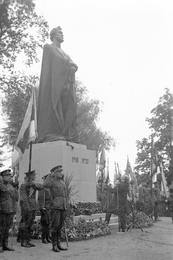70 years of Kalevipoeg. Will Kalevipoeg finally return home?
A story about the mood in Tartu and among students immediately after the statue of Kalevipoeg was taken down in 1950.
The story of the atmosphere in Tartu and among students after the statue of Kalevipoeg was taken down in 1950.
When it became apparent by the morning that the statue of Kalevipoeg had been taken down, people flocked to the crime scene to witness this injustice, among them the author of this article. The people of Tartu felt nothing but resentment for the destruction of this national symbol. Students continued to gather at the base of the statue throughout the spring. There must have been informants among them… The campaign sparked by the destruction of Kalevipoeg also touched upon the decline of the Estonian language for official proceedings. Magnus Kindlam published an article entitled ‘Opposing tendencies towards bourgeoisie nationalism’ in the newspaper Edasi on 30 April, in which he accused nationalists of opposing Russian loanwords in favour of Western loanwords. The wave of revelations in Tartu subsided by mid-summer and student gatherings at the site of the former statue came to an end at the start of the summer holidays. What had happened was irreversible and life had to go on, even without Kalevipoeg.
Eduard Vääri. 70 years with Kalevipoeg. Will Kalevipoeg finally come home? Culture and Life 2/2003. http://kultuur.elu.ee/ke472_kalevipoeg.htm
Related objects
Monument to the War of Independence in Tartu
This monument is situated on the right-hand bank of the Emajõgi River by Vabaduse Avenue (between the Vabaduse and Kaarsilla bridges) in Tartu.
Designed by Amandus Adamson, it was unveiled on 17 September 1933 and featured a cast-bronze sculpture of the Estonian epic hero Kalevipoeg leaning on his sword. The monument was removed in 1950, but as people continued to bring flowers and candles to the site, a bust of writer Friedrich Reinhold Kreutzwald was unveiled there in 1952. The restored monument, fashioned by sculptor Ekke Väli based on old photos, was unveiled on 22 June 2003.





